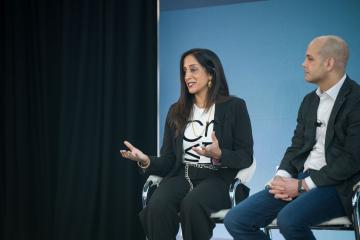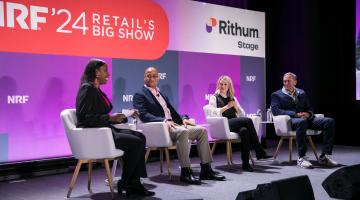
Kraft Heinz SVP and Head of North America Operations Helen Davis, Macy's Inc. SVP of Supply Chain Sean Barbour, Stitch Fix Data Science Manager of Merch Algos Sophie Searcy and Ocado Group Senior Vice President David Hardiman-Evans speak with Arteli Inc. CEO Martin Gilliard at NRF Supply Chain 360 Summit.
Data science, analytics and artificial intelligence can help retailers and consumer goods companies improve their supply chains in numerous ways, including making sure there are plenty of pickles on grocery store shelves.
Browse photos, blog posts, videos and more from NRF 2024: Retail’s Big Show.
“We just started creating this end-to-end visibility that’s completely connected to what’s happening on the store shelves through to our farmers,” said Helen Davis, head of North America Operations for Kraft Heinz, during the NRF Supply Chain 360 Summit at NRF 2024: Retail’s Big Show.
“Things like Klausen pickles, that’s usually 15 days from the time you harvest it to the time you see it on the shelf at stores, so we have to be able to react very, very fast.”
During a panel discussion moderated by Arteli Inc. CEO Martin Gilliard, Davis and other supply chain experts ran through the ways that machine learning and AI-powered solutions are allowing them to predict demand, optimize stock levels and monitor the real time status of inventory throughout the supply chain.
A self-driving supply chain
For Kraft Heinz, AI is allowing the food company to create a “self-driving supply chain” that can predict when factory lines will go down or when ingredients are available, and automatically make alternate decisions when there are disruptions.

“We’ve created a cognitive decision layer that sits on top of transactional data. We call that our lighthouse,” Davis said. “If an ingredient doesn’t come in or we can use a substitute, the system will come back and make that decision for us. First, we do recommendations, but after a while, it starts to see through machine learning, ‘Hey, you always make this choice, I’m now going to do it for you.’”
Similarly, British-based grocery technology company Ocado Group has found ways to leverage AI and data science to ensure that its grocery store clients can connect with the other side of supply chain inventory — the suppliers. That’s an especially important capability when dealing with things like fresh produce, dairy or meat.
“For us, it all starts with forecasting customer demand,” said Ocado Senior Vice President David Hardiman-Evans. “That enables us to work closely with a CPG and suppliers in making accurate orders.”
Having a more accurate forecasting model for inventory also allows grocery stores to cut down on waste, he said.
Fashion’s variability makes predictability a challenge
The use of AI and machine learning for inventory visibility and management is in the early stages for those in fashion and apparel such as legacy retailer Macy’s and online personal styling service Stitch Fix.
Apparel is a very different segment of retail, and 50% of Macy’s products annually are new products. Trying to predict what customers will want six or 12 months from now almost requires guessing, said Sean Barbour, senior vice president of supply chain at Macy’s.
Nevertheless, the company has a robust data science and analytics teams working to solve complex challenges, Barbour said. “The ingenuity of our data science and analytics teams to build the algorithms, to build the intelligence, to build the tools to help our buyers, our supply chain, our operators make optimal decisions, it’s what’s been really exciting about the past four years.”

Stitch Fix was founded based on the use of recommendation algorithms and data science to personalize clothing selections. But even data science and algorithms can’t predict what customers will want in the future, said Sophie Searcy, a data science manager at Stitch Fix. That’s why the brand continues to rely strongly on the human element, i.e., Stitch Fix’s personal stylists, retail partners and merchandising teams.
“There’s so much, especially in the fashion space, that’s just unknowable,” she said.
“Our best outcomes come when we actually partner with our merch team to rein in and really focus on the most important parts,” which, for Searcy and her team, comes down to creating real customer impact.


